Hi, I’m back again! For those of you who don’t know me from my previous articles or appearance on Wwise Up On Air, my name is Megan Carnes, and I’m a composer, audio implementer, and game designer. I’m currently making a game called Divinuet that generates unique musical experiences based on tarot readings. If you didn’t read my two previous posts, I’d suggest doing that before reading this one. Part 1 talks about the music I’m doing for the reading phase of the game, which features the individual themes of the cards you draw. Part 2 discusses the music system I had planned on using for the deterministic/generative phase of the game, where the cards you drew combine together to create a unique cohesive piece of music.
You may have noticed that I used past tense in that last sentence. That’s because I ended up completely scrapping that music system and replacing it with a new one. That’s what I’ll be discussing in this article: why the old system ended up not working, what I needed to change, and what I ended up doing for the system I’m using instead. I learned a lot in the process, and I’m excited to share what I learned with you!
Musical goals and why the first attempt fell short
The generative section of Divinuet is a little more nebulous than the reading section. Why not just have each card play its individual theme and end the game there? But a tarot reading is about so much more than the individual cards - it’s about a more holistic perspective, the combination of the cards together. So while having the individual card themes was important, I wanted to end each reading with a piece that would represent the entire thing.
There were four main goals I was trying to achieve with this music:
1) The music should sound noticeably different with different readings. That meant doing more than just reusing the same melody/chords and changing the instrumentation, which I figured would quickly become very obvious after doing a few readings. It’s important to me that each reading feels like a new experience.
2) The music should reflect the meanings of the cards in the reading. This is a pretty obvious one, but I didn’t want the music to be random. I wanted what you heard to reflect if you had a reading that was mostly positive vs. mostly negative, mostly about energy/action vs. mostly about rest/reflection, etc. I wanted the order of the cards to be reflected in the music as well, because for example, if your first card is very negative and your last card is very positive, that’s a much different reading than if their positions were switched.
3) Each card should be given equal musical weight. Each card in the reading is equally important, and therefore each card should have an equal part in determining how the music will sound. No one card should be featured more than the others.
4) It should sound musical. Kind of a weird one. Of course music should sound musical, right? But sometimes dynamic music has the problem of sounding like a bunch of stems randomly stacked on top of each other, or random phrases playing one after the other, without really sounding like one cohesive piece. Basically, I wanted it to sound like a fully composed piece, where every note, chord, and phrase is there for a reason.
The first version of the generative music, with its wildly varying instrumentation and chord progressions, certainly sounded different with each reading. And it definitely reflected each individual card’s meaning very effectively. The problems were with the last 2 criteria.
The way the old system worked, Card 1, being both the lowest of the card layers and the first layer to come in, always influenced the sound and feel of the music more than the other two. I tried a few things to mitigate that. One thing I tried was after the Card 1 layer played its melody and became accompaniment for the other two card layers, I waited awhile to have the Card 1 layer play a melody again, hoping that would draw your ear more to the other two layers. But no matter what I did, to me, the first card layer always felt like the “main” one, when the goal was for all the card layers to have equal importance.
The other problem was that it just didn’t feel very musical. It sounded like several distinct layers stacked on top of each other, rather than one cohesive piece. I think this was because of a few factors. With so many different possible instrument combinations, some just didn’t mesh together well. The choice to only have the accompaniment play one note/octaves while the layer with the melody played the chords not only led to super boring accompaniment, it also made it feel like the different parts weren’t really playing the same piece. Basically, the music sounded like exactly what it was - layers written to be able to technically not clash with several other possible layers. It wasn’t terrible, but I knew I could do better.
Here’s a demo of a piece of music that the old system would have made.
It’s not awful. Certain sections of it actually sound pretty cool. But to me, it mostly just sounds like a bunch of disparate parts put together instead of a deliberately composed piece of music.
The new system
Deciding to completely redo the music for the generative phase of the game was a tough choice. After all, I was essentially trashing months of work. But once I decided to do it, I knew I had to approach the new music system with a more musical intention. With the first system, I’d been so excited about the interactive elements of the music that I’d forgotten to pay attention to my instincts as a composer.
The main question I asked myself when creating the new system was this: how can I make each instance of the generative phase of Divinuet sound like a fully composed piece of music, rather than a pieced-together assortment of musical building blocks?
I knew I had to do away with the accompaniment only being allowed to play one note rule. I would never compose accompaniment like that in any other situation (except for occasional pedal notes, which I would only do for a phrase or two at most, never an entire piece), because it’s just super boring musically. So I knew I shouldn’t do it here either.
I also wanted to limit the instrumentation. Even if it meant my musical palette would be smaller, it would allow me to purposely pick instruments that I knew would all go well together.
Finally, I realized that each card representing a layer wasn’t working. Instead, I decided to take a more horizontal approach. Each of the three cards would have a segment of music, and they’d all play in a row, with other elements tying them together to make it sound like one piece of music rather than 3 short pieces playing in one after the other.
So here’s what I ended up with! I’ll show you a few visuals I made for my VGMTogether talk about Divinuet’s music systems, and then explain what they mean.
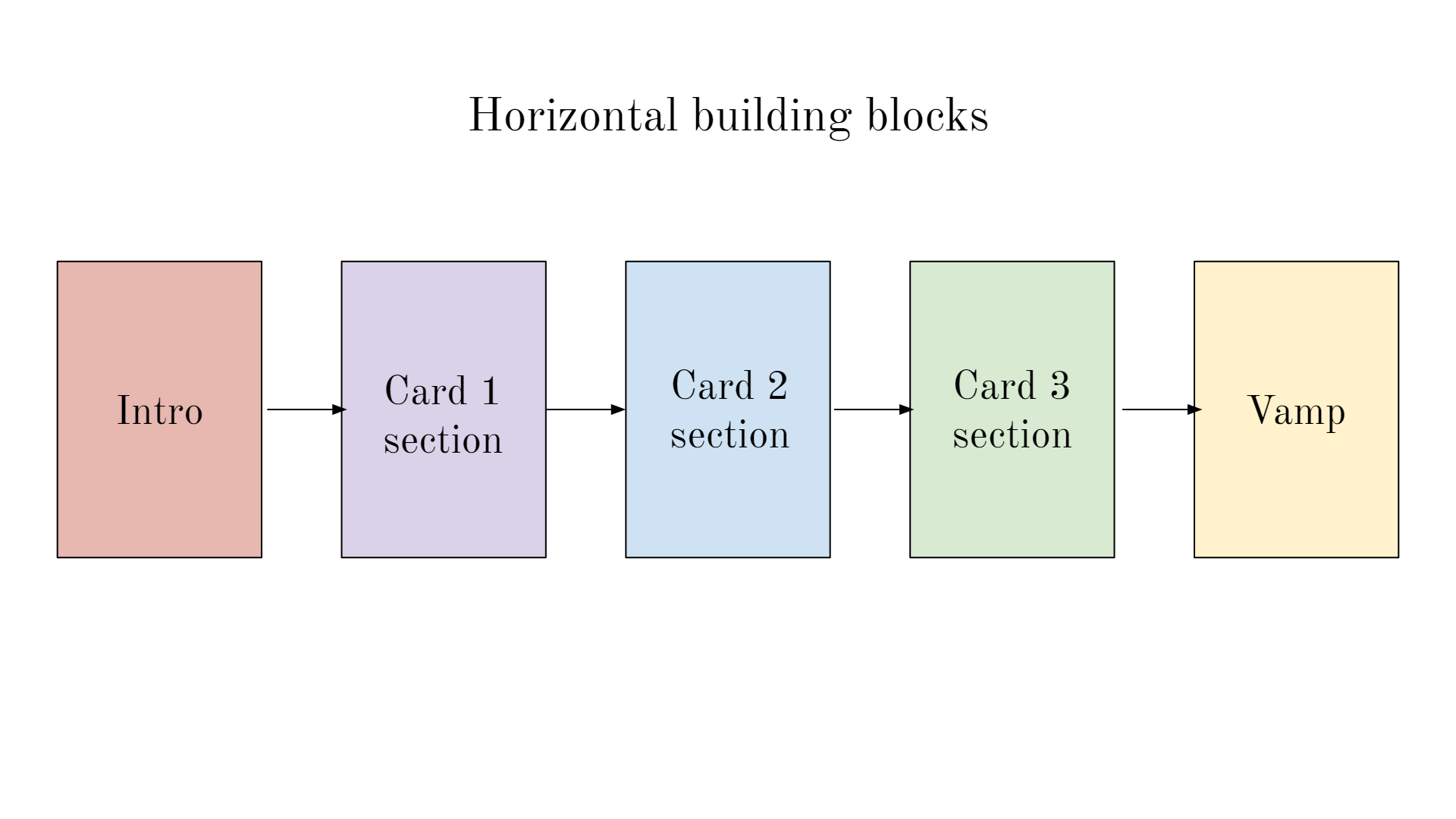
The music is structured as shown in the diagram above. Pretty straightforward! At the end of the piece, the vamp will loop until the player decides whether they’d like to continue to the credits or listen to the piece again. Each of these horizontal building blocks is made of up to 3 stems/layers, as shown below:
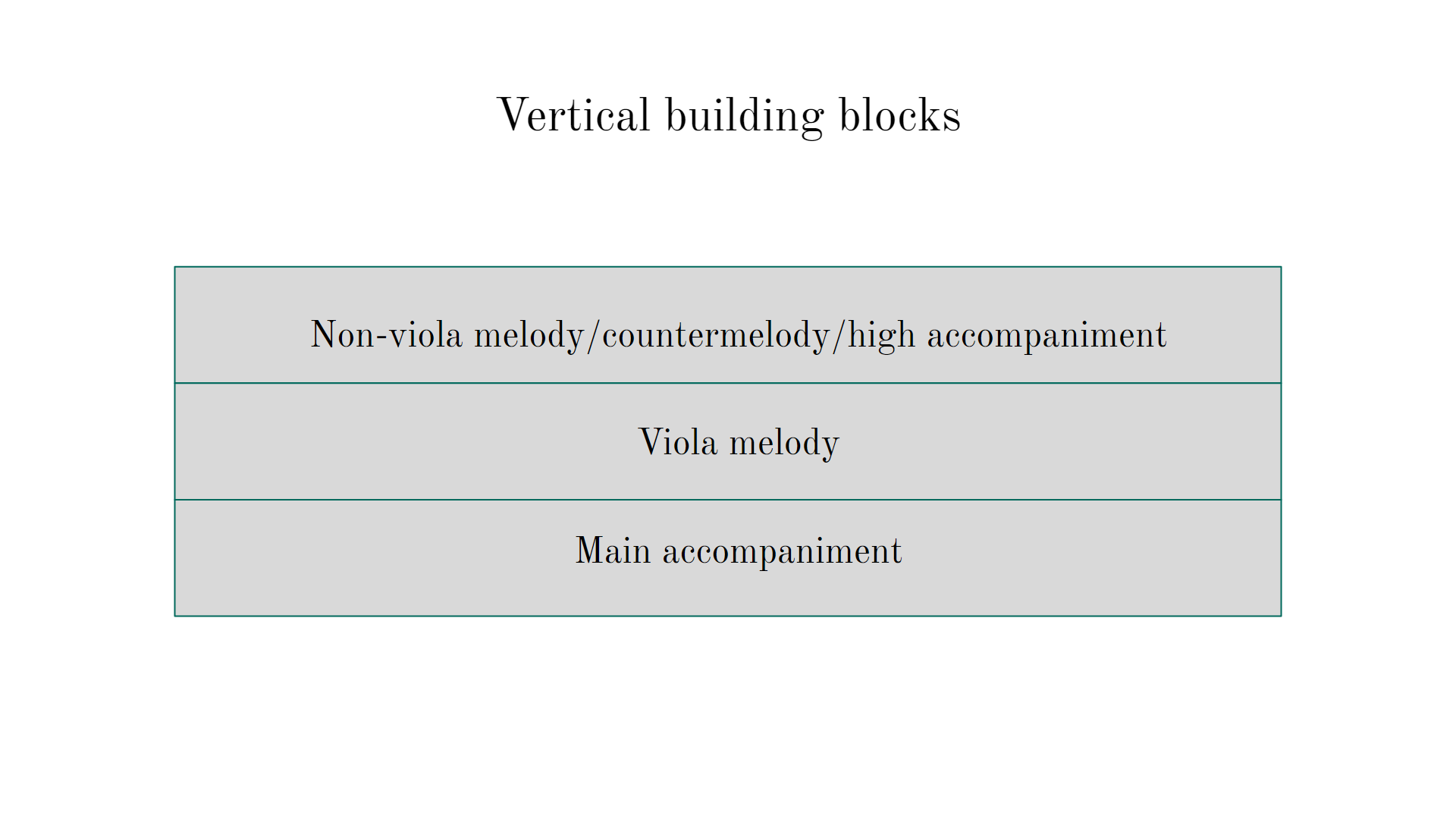
Every section of the piece will have the main accompaniment. The instrumentation of the main accompaniment is determined by whichever suit is the majority in your reading. There are six instrumentation options: major arcana, swords, wands, cups, pentacles, or no majority (for when each of your cards is a different suit).
The intro and vamp sections only have the main accompaniment playing. The other sections (Card 1, Card 2, and Card 3) each also contain a viola melody, performed by the amazing violist Drew Forde. They also each have a non-viola melody/counter-melody/high accompaniment, the instrumentation of which is determined by each individual card’s suit. Major arcana is harp, cups is piano, wands is kalimba, swords is wurlitzer, and pentacles is dulcimer. So for example, if your reading was 4 of Cups, 2 of Wands, King of Swords, you’d hear a piano during the Card 1 section, a kalimba during the Card 2 section, and a wurlitzer during the Card 3 section.
Altogether, having the main accompaniment and viola play consistently helps tie the music together, while having different possible instruments for the non-viola melodies adds some differentiation between the individual cards. The harmonies, melodies, and rhythms do this too.
I’ve divided the cards into 13 different thematic groups based on their meanings. These vary a lot, since the meanings of tarot cards are all so different. To give you an idea, four of the groups are joy, tragedy, peace, and ambition. So that gives me a ton of room to play around musically with each group! I use each individual card’s thematic group to determine the chord progression and melodies that happen during its corresponding section of music. So here’s what that looks like:
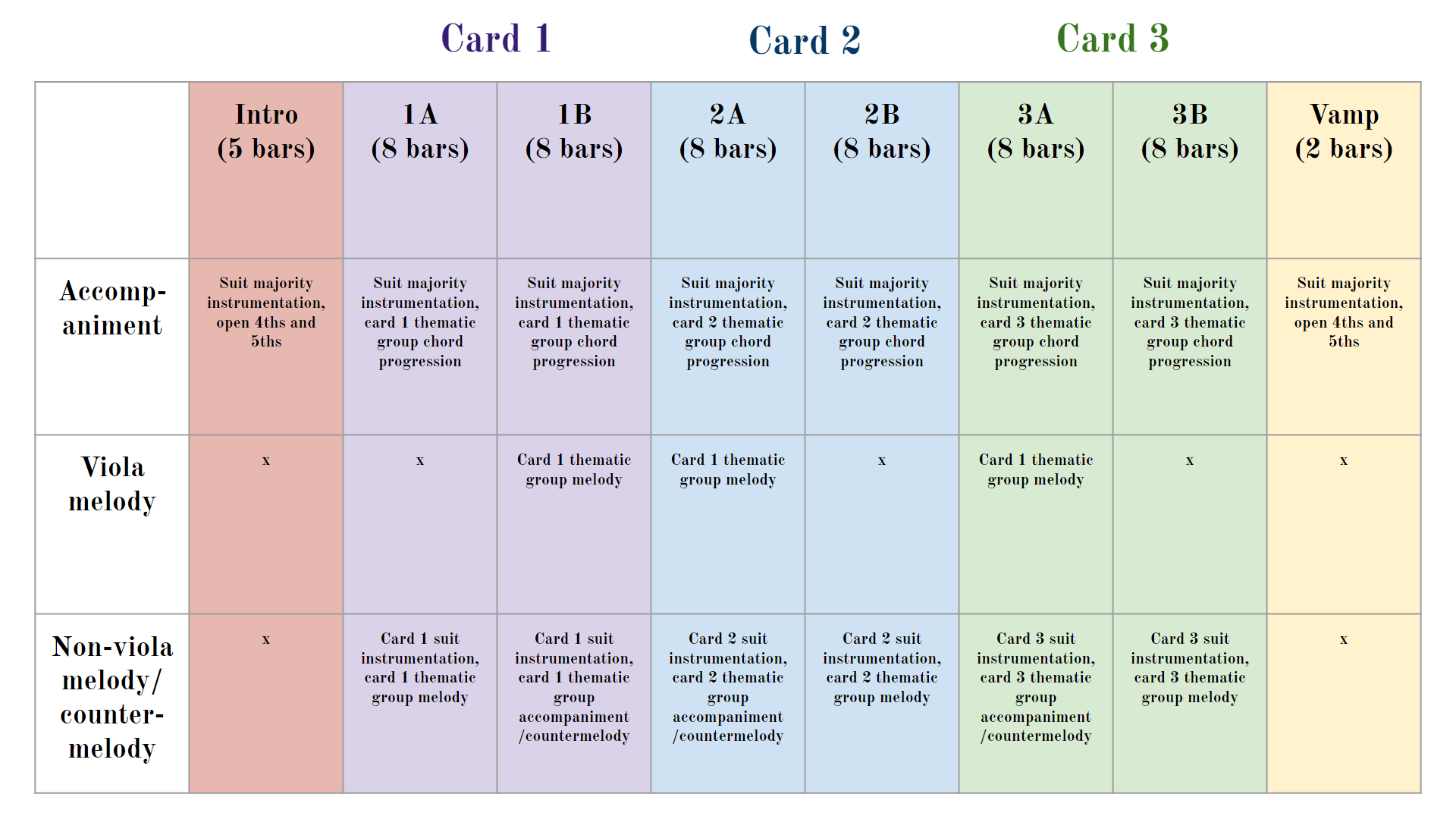
Since each card has a thematic group chord progression tied to it for each of the 3 sections, depending on where it appears in the reading, I no longer have to do the accompaniment playing just one note thing. Rather, each of the layers can play anything that fits within the chord progression. There are 4 different possible progressions, each connected to 3 or 4 different thematic groups. Those are as follows:
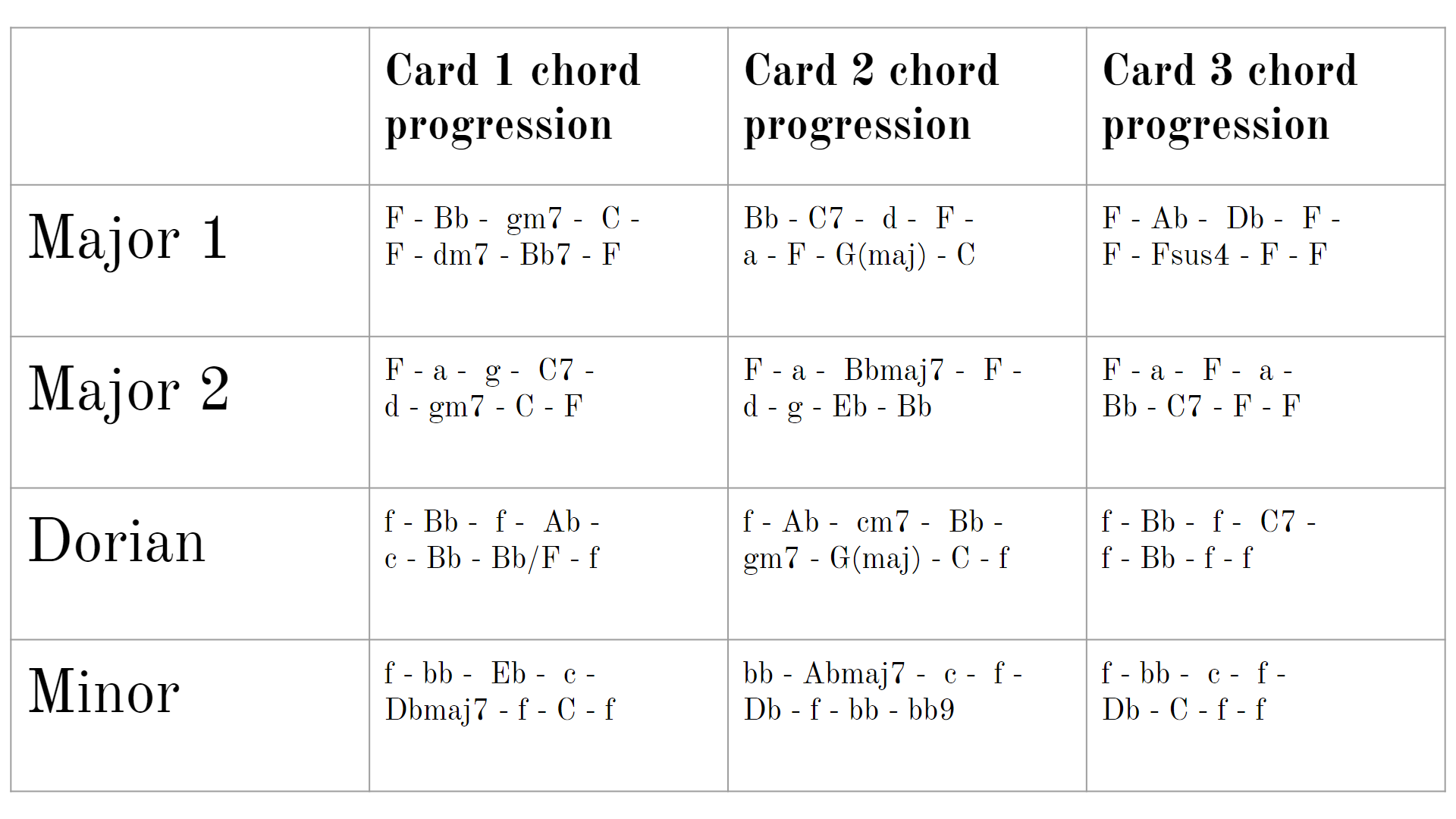
So for example, if you had a reading where your first card was a very positive card, your second card was a neutral/mixed card, and your third card was a negative card, you’d hear Card 1 Major 1, then Card 2 Dorian, then Card 3 Minor.
You may have also noticed that everything is in F (whether it’s major, minor, or dorian mode). This makes it so that switching between different keys for different cards is always smooth. The intro and vamp are made of just the root, 4th, and 5th (F, Bb, and C) so they don’t suggest one key over another and can easily transition into or out of any of the possible chord progressions.
With the consistent instrumentation tying things together horizontally and the set chord progressions making it easy for me to make everything cohesive vertically, I was really able to have fun with the melodies and make them all very different from each other. Each thematic group has specific melodies for each of the card sections. There’s a wide variety of rhythms, ranges, and overall tones while still sticking to whatever chord progression is associated with each one’s respective thematic group.
For example, here are two viola melodies for the Card 1 section. Both are in dorian mode, but feel very different from each other.
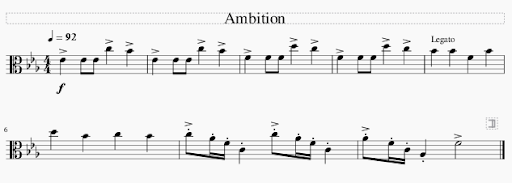

So now for the moment of truth: what does this all sound like together? I’ve put together an example reading.
Example reading
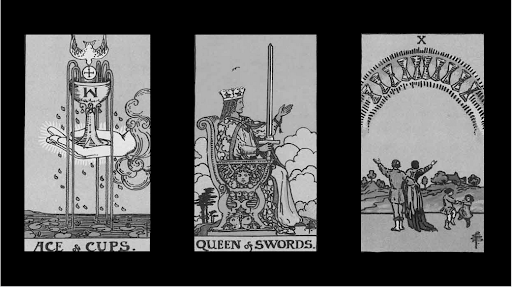
In this reading, the first card represents an abundance of love, creativity, and good emotions, the second card represents being ambitious and sharp, and the third card represents feeling fulfilled in your relationships and home life. The card majority is cups, which tend to represent emotions, relationships, and creativity. The piece will be structured as follows:
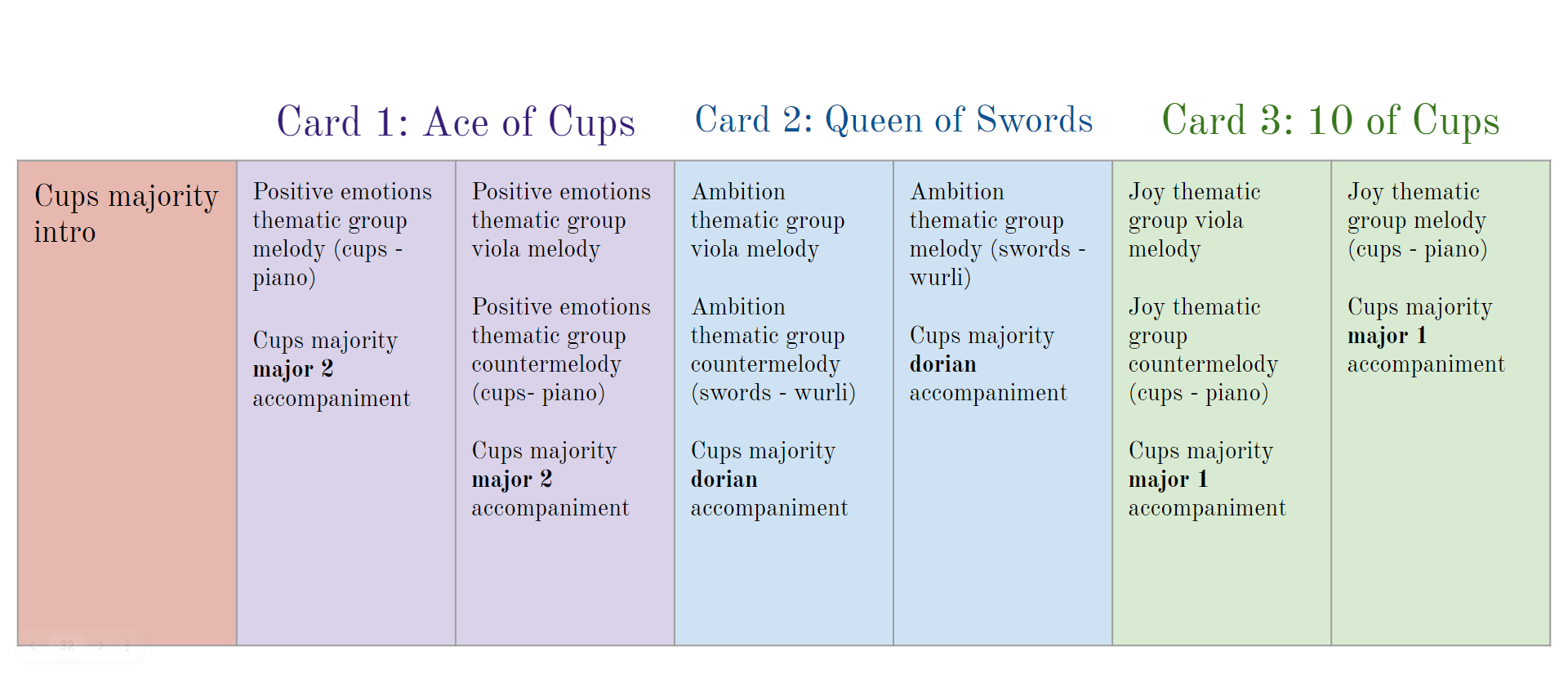
Take a listen to how it sounds!
Compared to the music from the old system, this feels much, much more like a pre-composed piece of music, rather than random stems thrown together, while still giving each card a distinct sound and time in the spotlight. And with each card getting its own section, they’re never fighting each other for your attention.
One other thing you may have noticed in the piece was that at the beginning of the Card 2 and Card 3 sections (around 0:55 and 1:36), I used pickup notes. These help certain melodies feel more musical and the sections feel more connected to each other. Whenever I had a pickup note in a new section, I just checked to make sure it didn’t clash with any of the possible chords that would be playing while the pickup note played. With that handy dandy chord progression chart I made, it was actually pretty easy to do.
Now let’s listen to the music that’s created by another reading for comparison.
Example reading: a comparison

In this reading, the first card represents a glimmer of hope after dark times, the second card represents endings and transitions, and the third card is our Queen of Swords again, representing being ambitious and sharp. The suit majority is major arcana, which represents big life events and major themes.
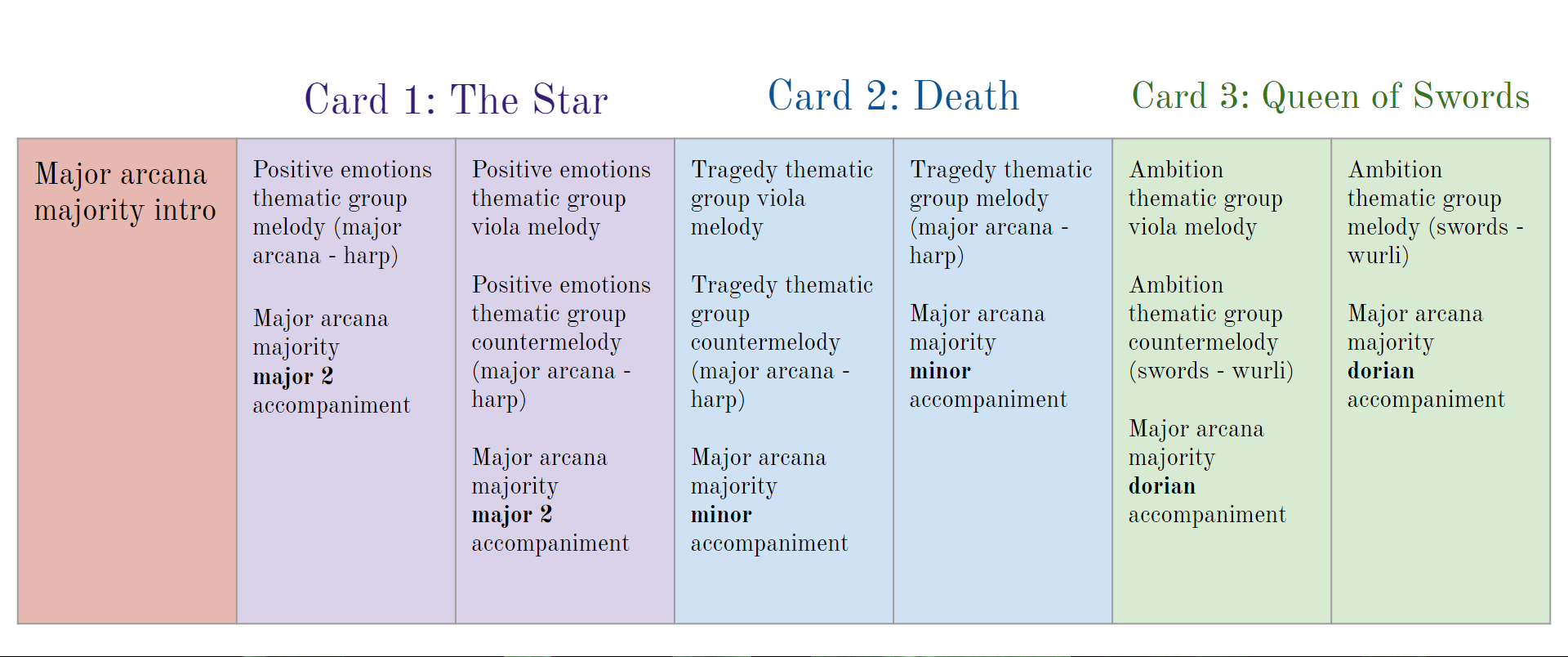
The Star is actually in the same thematic group as Ace of Cups, so you’ll hear the same melody in the Card 1 section, but with a harp playing the non-viola melody instead of a piano. And I threw Queen of Swords in there again, but as Card 3 instead of Card 2 this time in order to show how the same cards/thematic groups in different positions have completely different melodies and chord progressions. And of course, the music will have the major arcana accompaniment instead of the cups accompaniment.
So here’s what it sounds like!
Hopefully that gives you an idea of how even similar readings can end up sounding very different from each other. I’m excited to get the game finished so people can try out tons of different combinations!
I’m very, very glad I decided to replace my old music system with this one. Making such a major change was a huge deal and meant getting rid of a bunch of work, but I ended up with something so much better. If your instincts are telling you that something’s not working, even if you’ve invested a lot of time into it, don’t be afraid to start fresh.
If you’d like to learn more about this music system, including seeing how it’s set up in Wwise and how it uses callbacks to create a music video to go along with the music it creates, I’d suggest checking out my episode of Wwise Up On Air, where I gave Damian an in-depth tour of the game and its music in Wwise and Unity!
Thanks so much for reading about my weird artsy tarot music game! If you’re interested in learning more or want to keep up with Divinuet news, you can follow my Twitter, Divinuet’s Twitter, or the Indiegogo page. And if you’d like to hear more of my composition work or learn more about me in general, please check out my website.

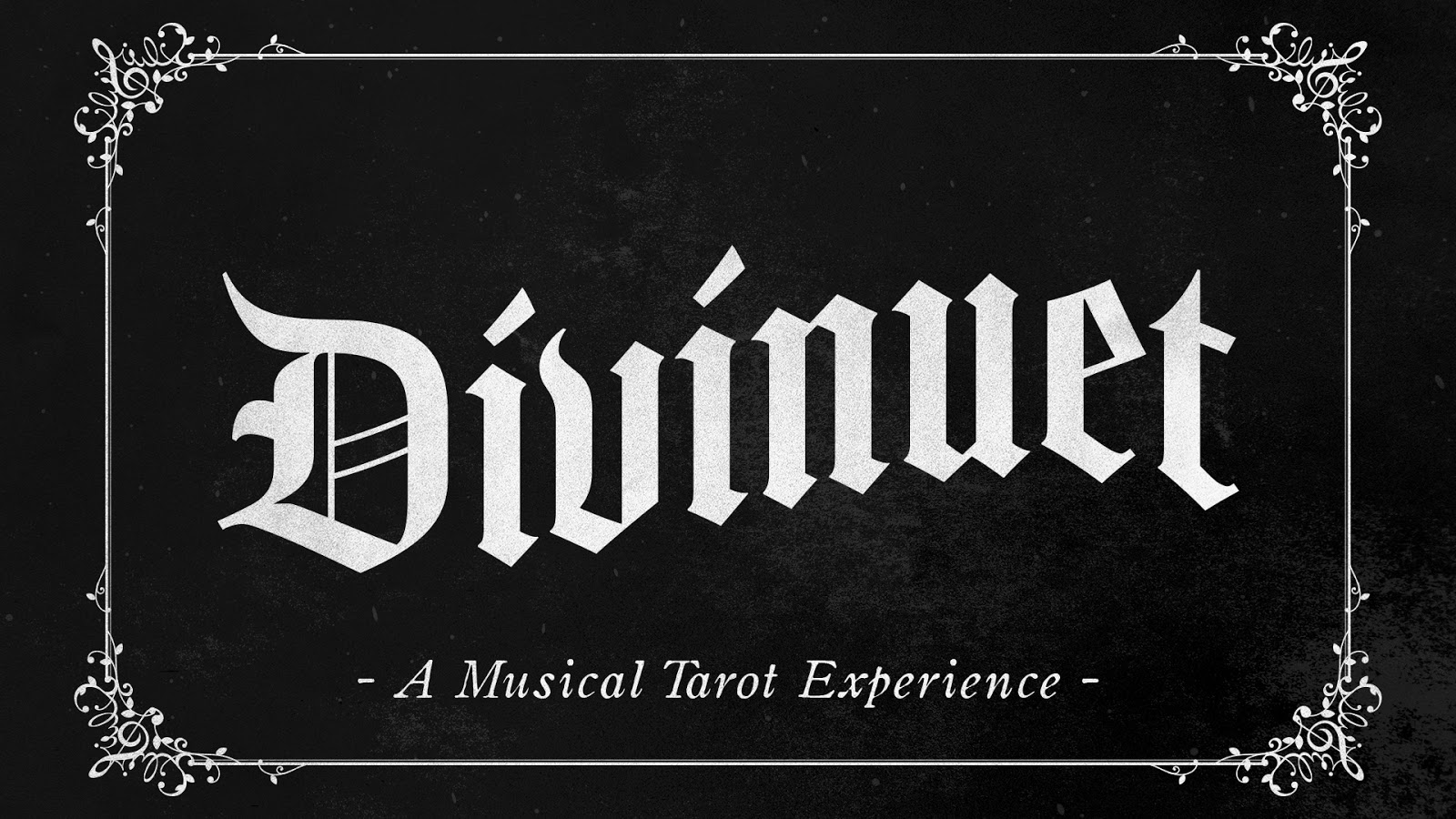
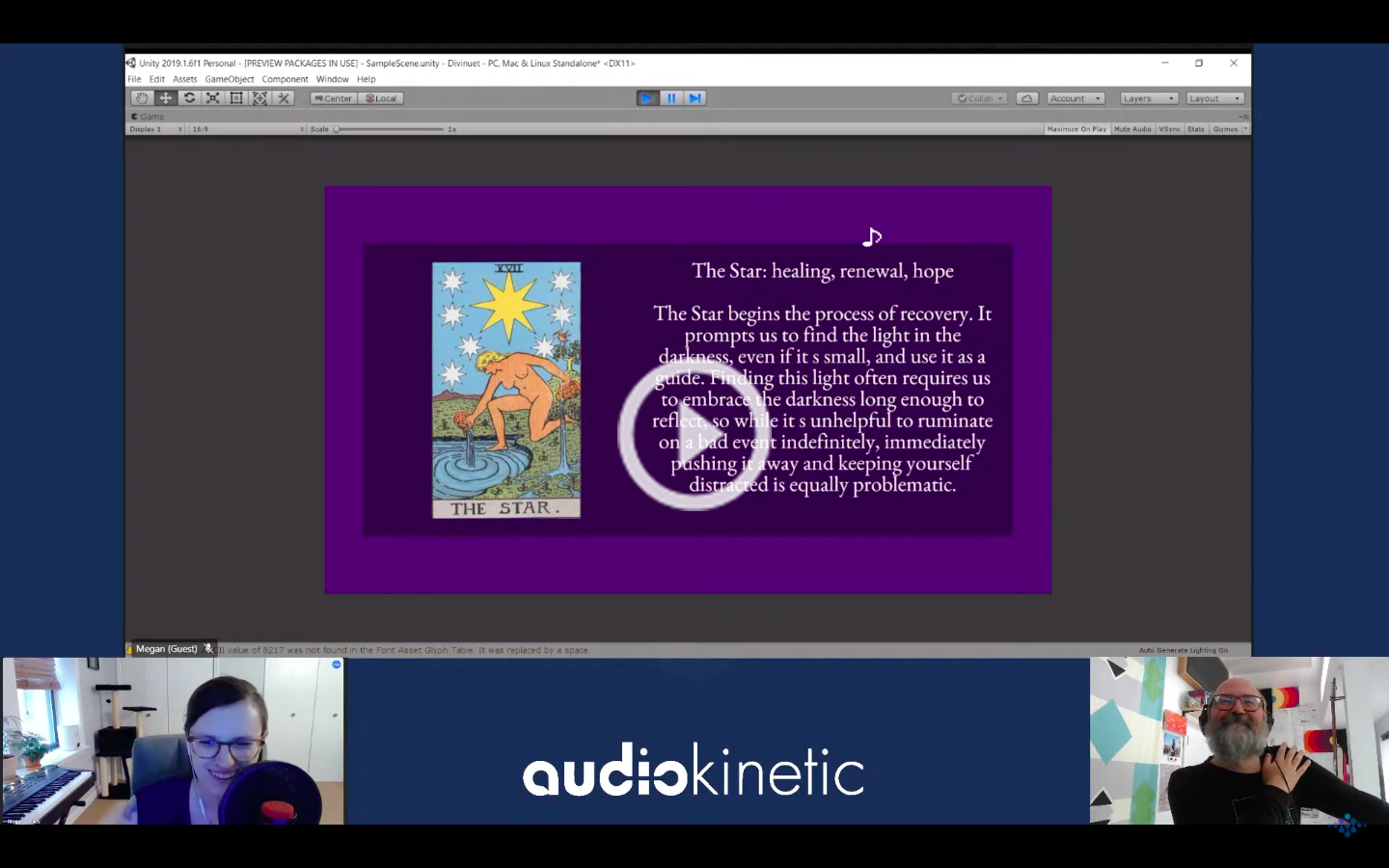

Comments